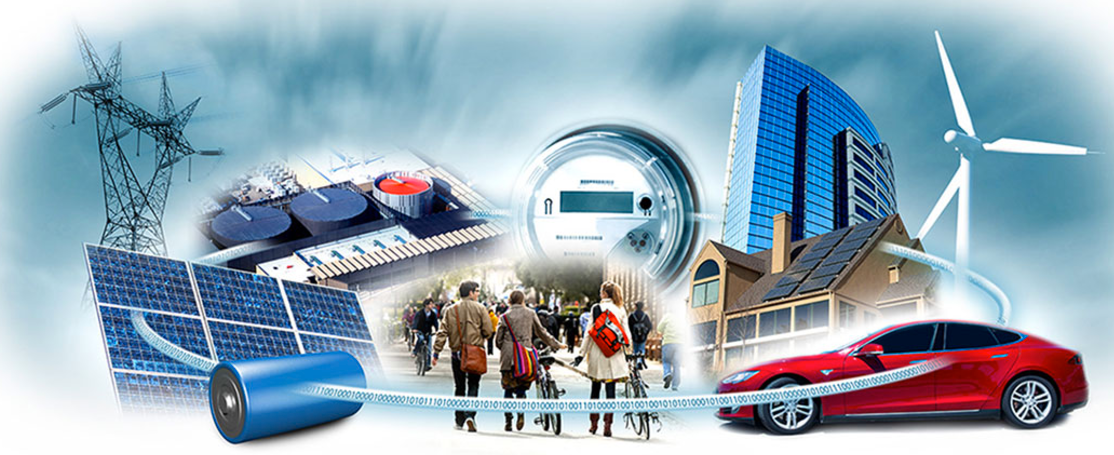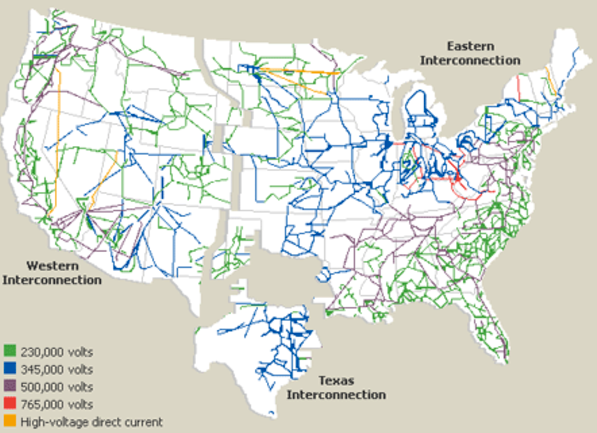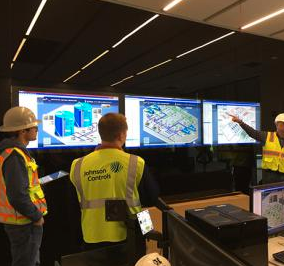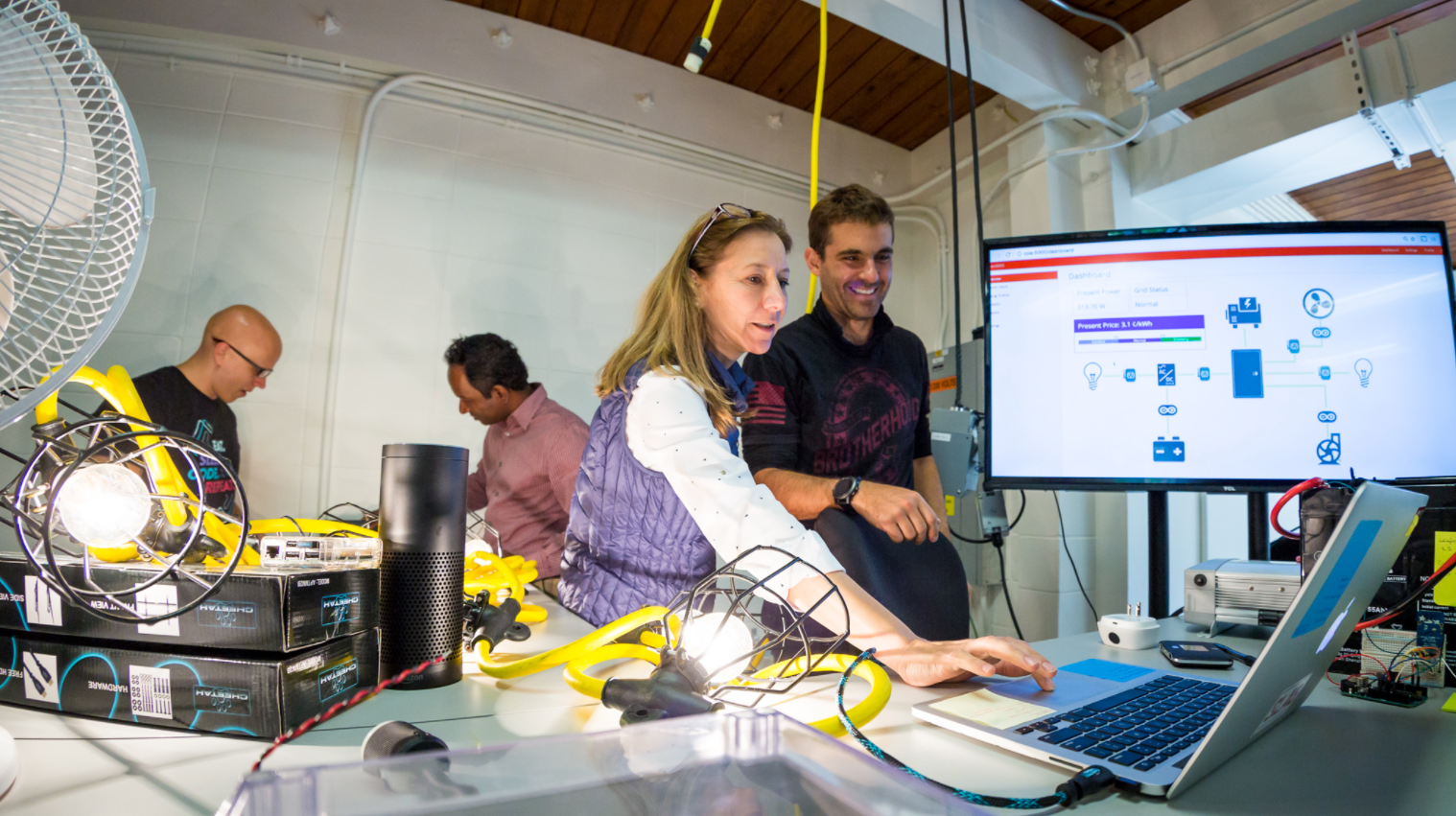‘Bits & Watts’: integrating inexpensive energy sources into the electric grid
October 25, 2016

Bits & Watts initiative (credit: SLAC National Accelerator Laboratory)
Stanford University and DOE’s SLAC National Accelerator Laboratory launched today an initiative called “Bits & Watts” aimed at integrating low-carbon, inexpensive energy sources, like wind and solar, into the electric grid.
The interdisciplinary initiative hopes to develop “smart” technology that will bring the grid into the 21st century while delivering reliable, efficient, affordable power to homes and businesses.
That means you’ll be able to feed extra power from a home solar collector, for instance, into the grid — without throwing it off balance and triggering potential outages.

The three U.S. power grids (credit: Microsoft Encarta Encyclopedia)
A significant challenge. For starters, the U.S. electric grid is actually two giant, continent-spanning networks, plus a third, smaller network in Texas, that connect power sources and consumers via transmission lines. Each network runs like a single machine, with all its parts humming along at the same frequency, and their operators try to avoid unexpected surges and drops in power that could set off a chain reaction of disruptions and even wreck equipment or hurt people.
Remember the Northeast blackout of 2003, the second largest in history? It knocked out power for an estimated 45 million people in eight U.S. states and 10 million people in the Canadian province of Ontario, some for nearly a week.

“The first challenge was to bring down the cost of wind, solar and other forms of distributed power. The next challenge is to create an integrated system. We must develop the right technologies, financial incentives and investment atmosphere to take full advantage of the lowering costs of clean energy.” — Steven Chu, a Stanford professor, Nobel laureate, former U.S. Energy Secretary, and one of the founding researchers of Bits & Watts. (credit: U.S. Department of Energy)
“Today’s electric grid is … an incredibly complex and finely balanced ecosystem that’s designed to handle power flows in only one direction — from centralized power plants to the consumer,” explained Arun Majumdar, a Stanford professor of mechanical engineering who co-directs both Bits & Watts and the university’s Precourt Institute for Energy, which oversees the initiative.
“As we incorporate more low-carbon, highly variable sources like wind and solar — including energy generated, stored and injected back into the grid by individual consumers — we’ll need a whole new set of tools, from computing and communications to controls and data sciences, to keep the grid stable, efficient and secure and provide affordable electricity.”

Coordination and integration of transmission and distribution systems (credit: SLAC National Accelerator Laboratory)
The initiative also plans to develop market structures, regulatory frameworks, business models and pricing mechanisms that are crucial for making the grid run smoothly, working with industry and policymakers to identify and solve problems that stand in the way of grid modernization.
(Three bigger grid problems the Stanford announcement today didn’t mention: a geomagnetic solar storm-induced Carrington event, an EMP attack, and a grid cyber attack.)
Simulating the Grid in the Lab

Sila Kiliccote, head of SLAC’s GISMo (Grid Integration, Systems and Mobility) lab, and Stanford graduate student Gustavo Cezar look at a computer dashboard showing how appliances, batteries, lighting and other systems in a “home hub” network could be turned on and off in response to energy prices, consumer preferences and demands on the grid. The lab is part of the Bits & Watts initiative. (credit: SLAC National Accelerator Laboratory)
Researchers will develop ways to use digital sensors and controls to collect data from millions of sources, from rooftop solar panels to electric car charging stations, wind farms, factory operations and household appliances and thermostats, and provide the real-time feedback grid operators need to seamlessly incorporate variable sources of energy and automatically adjust power distribution to customers.
All of the grid-related software developed by Bits & Watts will be open source, so it can be rapidly adopted by industry and policymakers and used by other researchers.
The initiative includes research projects that will:
- Simulate the entire smart grid, from central power plants to networked home appliances (Virtual Megagrid).
- Analyze data on electricity use, weather, geography, demographic patterns, and other factors to get a clear understanding of customer behavior via an easy-to-understand graphical interface (VISDOM).
- Develop a “home hub” system that controls and monitors a home’s appliances, heating and cooling and other electrical demands and can switch them on and off in response to fluctuating electricity prices, demands on the power grid, and the customer’s needs (Powernet).
- Gather vast and growing sources of data from buildings, rooftop solar modules, electric vehicles, utility equipment, energy markets and so on, and analyze it in real time to dramatically improve the operation and planning of the electricity grid (VADER). This project will incorporate new data science tools such as machine learning, and validate those tools using data from utilities and industry.
- Create a unique data depository for the electricity ecosystem (DataCommons).
Through the Grid Modernization Initiative, initial Bits & Watts projects are being funded for a combined $8.6 million from two DOE programs, the Advanced Research Projects Agency-Energy (ARPA-E) and the Grid Modernization Laboratory Consortium; $2.2 million from the California Energy Commission; and $1.6 million per year from industrial members, including China State Grid, PG&E (Pacific Gas & Electric), innogy SE (formerly RWE), Schneider Electric and Meidensha Corp.